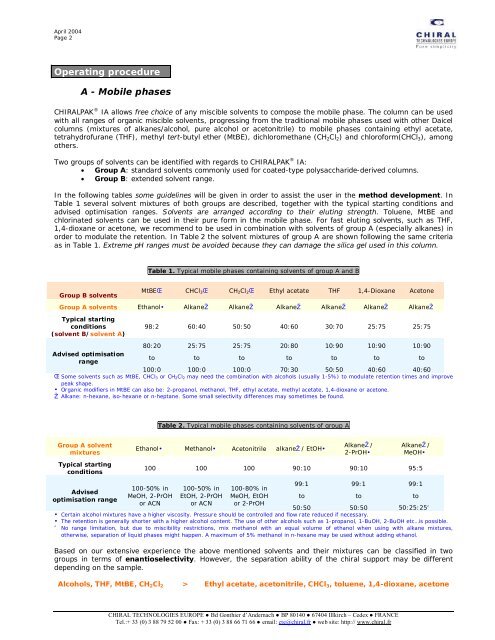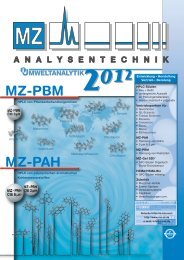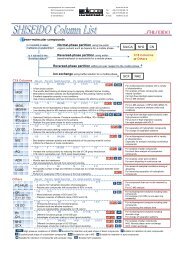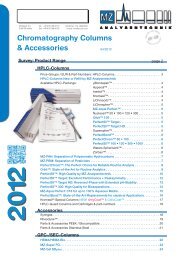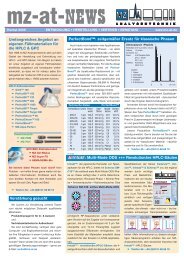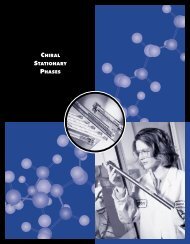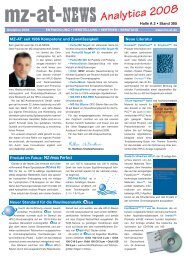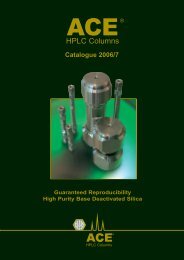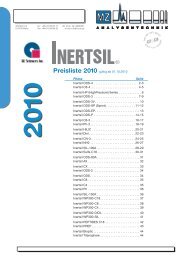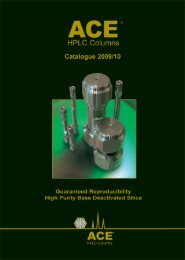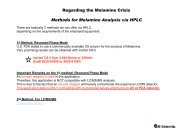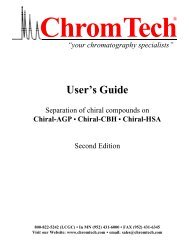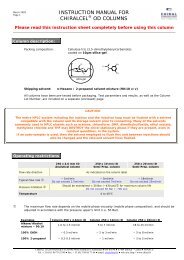Column cleaning and regeneration procedures
Column cleaning and regeneration procedures
Column cleaning and regeneration procedures
You also want an ePaper? Increase the reach of your titles
YUMPU automatically turns print PDFs into web optimized ePapers that Google loves.
April 2004<br />
Page 2<br />
Operating procedure<br />
A - Mobile phases<br />
CHIRALPAK ® IA allows free choice of any miscible solvents to compose the mobile phase. The column can be used<br />
with all ranges of organic miscible solvents, progressing from the traditional mobile phases used with other Daicel<br />
columns (mixtures of alkanes/alcohol, pure alcohol or acetonitrile) to mobile phases containing ethyl acetate,<br />
tetrahydrofurane (THF), methyl tert-butyl ether (MtBE), dichloromethane (CH2Cl2) <strong>and</strong> chloroform(CHCl3), among<br />
others.<br />
Two groups of solvents can be identified with regards to CHIRALPAK ® IA:<br />
• Group A: st<strong>and</strong>ard solvents commonly used for coated-type polysaccharide-derived columns.<br />
• Group B: extended solvent range.<br />
In the following tables some guidelines will be given in order to assist the user in the method development. In<br />
Table 1 several solvent mixtures of both groups are described, together with the typical starting conditions <strong>and</strong><br />
advised optimisation ranges. Solvents are arranged according to their eluting strength. Toluene, MtBE <strong>and</strong><br />
chlorinated solvents can be used in their pure form in the mobile phase. For fast eluting solvents, such as THF,<br />
1,4-dioxane or acetone, we recommend to be used in combination with solvents of group A (especially alkanes) in<br />
order to modulate the retention. In Table 2 the solvent mixtures of group A are shown following the same criteria<br />
as in Table 1. Extreme pH ranges must be avoided because they can damage the silica gel used in this column.<br />
Group B solvents<br />
Table 1. Typical mobile phases containing solvents of group A <strong>and</strong> B<br />
MtBE CHCl3 CH2Cl2 Ethyl acetate THF 1,4-Dioxane Acetone<br />
Group A solvents Ethanol Alkane Alkane Alkane Alkane Alkane Alkane<br />
Typical starting<br />
conditions<br />
(solvent B/solvent A)<br />
98:2 60:40 50:50 40:60 30:70 25:75 25:75<br />
80:20 25:75 25:75 20:80 10:90 10:90 10:90<br />
Advised optimisation<br />
range<br />
to<br />
to<br />
to<br />
to<br />
to<br />
to<br />
to<br />
100:0 100:0 100:0 70:30 50:50 40:60 40:60<br />
Some solvents such as MtBE, CHCl3 or CH2Cl2 may need the combination with alcohols (usually 1-5%) to modulate retention times <strong>and</strong> improve<br />
peak shape.<br />
Organic modifiers in MtBE can also be: 2-propanol, methanol, THF, ethyl acetate, methyl acetate, 1,4-dioxane or acetone.<br />
Alkane: n-hexane, iso-hexane or n-heptane. Some small selectivity differences may sometimes be found.<br />
Group A solvent<br />
mixtures<br />
Typical starting<br />
conditions<br />
Advised<br />
optimisation range<br />
Table 2. Typical mobile phases containing solvents of group A<br />
Ethanol Methanol Acetonitrile alkane / EtOH<br />
Alkane /<br />
2-PrOH<br />
CHIRAL TECHNOLOGIES EUROPE ● Bd Gonthier d’Andernach ● BP 80140 ● 67404 Illkirch – Cedex ● FRANCE<br />
Tel.:+ 33 (0) 3 88 79 52 00 ● Fax: + 33 (0) 3 88 66 71 66 ● email: cte@chiral.fr ● web site: http:// www.chiral.fr<br />
Alkane /<br />
MeOH<br />
100 100 100 90:10 90:10 95:5<br />
100-50% in<br />
MeOH, 2-PrOH<br />
or ACN<br />
100-50% in<br />
EtOH, 2-PrOH<br />
or ACN<br />
100-80% in<br />
MeOH, EtOH<br />
or 2-PrOH<br />
99:1<br />
to<br />
50:50<br />
99:1<br />
to<br />
50:50<br />
99:1<br />
to<br />
50:25:25<br />
Certain alcohol mixtures have a higher viscosity. Pressure should be controlled <strong>and</strong> flow rate reduced if necessary.<br />
The retention is generally shorter with a higher alcohol content. The use of other alcohols such as 1-propanol, 1-BuOH, 2-BuOH etc…is possible.<br />
No range limitation, but due to miscibility restrictions, mix methanol with an equal volume of ethanol when using with alkane mixtures,<br />
otherwise, separation of liquid phases might happen. A maximum of 5% methanol in n-hexane may be used without adding ethanol.<br />
Based on our extensive experience the above mentioned solvents <strong>and</strong> their mixtures can be classified in two<br />
groups in terms of enantioselectivity. However, the separation ability of the chiral support may be different<br />
depending on the sample.<br />
Alcohols, THF, MtBE, CH2Cl2 > Ethyl acetate, acetonitrile, CHCl3, toluene, 1,4-dioxane, acetone


